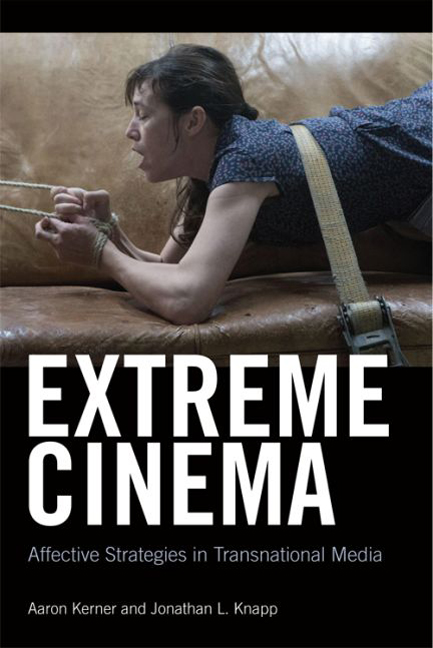Book contents
- Frontmatter
- Contents
- List of Figures
- Acknowledgments
- 1 Extreme Cinema: Revisiting Body Genres
- 2 Hearing: With a Touch of Sound—The Affective Charge of Audio Design
- 3 Pain: Exploring Bodies, Technology, and Endurance
- 4 Laughter: Belly-aching Laughter
- 5 Arousal: Graphic Encounters
- 6 Crying: Dreadful Melodramas—Family Dramas and Home Invasions
- 7 The End of Extreme Cinema?
- Bibliography
- Filmography
- Index
4 - Laughter: Belly-aching Laughter
- Frontmatter
- Contents
- List of Figures
- Acknowledgments
- 1 Extreme Cinema: Revisiting Body Genres
- 2 Hearing: With a Touch of Sound—The Affective Charge of Audio Design
- 3 Pain: Exploring Bodies, Technology, and Endurance
- 4 Laughter: Belly-aching Laughter
- 5 Arousal: Graphic Encounters
- 6 Crying: Dreadful Melodramas—Family Dramas and Home Invasions
- 7 The End of Extreme Cinema?
- Bibliography
- Filmography
- Index
Summary
The laugh being one of the few uncensored channels of affective expression may become the prime vehicle of the expression of any and all affects which suffer inhibition. Thus there is the frightened nervous laugh, the dirty laugh of contempt or hostility, the ashamed laugh, the surprised laugh, the laugh of enjoyment, the laugh of excitement and the laugh of distress, the substitute cry.
— Silvan TomkinsINTRODUCTION: “WHAT's SO FUNNY?” IS PROBABLY THE WRONG QUESTION …
As Linda Williams argues in Hard Core, cinematic hardcore showcases the quest to document proof of the female orgasm. Complicated by the fact that the female orgasm is generally invisible to the unaided eye, the pornographic genre displaces the female orgasm onto the visual choreography of the money shot. At least for one, the male orgasm is impossible to fake—ejaculation is a confession of the male body, proof of sexual excitation and climactic release. The pornographic genre anticipates a spectator's mutual arousal; the comic genre, or comedic numbers in a film, also anticipates an affective response from the spectator, but in the form of laughter. “True laughter cannot be forced or faked,” Tarja Laine observes, and, like pornography's “money shot,” laughter manifests itself as a confession of the body. Pornography invites its spectators to mimic, or perhaps even in a sense to participate in, the arousing experience. What sets pornography and the cinematic numbers that elicit laughter in the viewing body apart is that within the story-world things might be horrifying, dreadful, or deadly serious, but nonetheless cause the spectator to erupt hysterically. There is, then, with laughter the possibility for dissonance between the diegetic narrative and how the spectator responds to it. This is precisely why Williams does not count comedy as part of the body genres; “the reaction of the audience does not mimic the sensations experienced” by the character(s) onscreen. She also notes that in the genre we are generally encouraged to laugh at, not with the character onscreen.
Be that as it may, laughter nonetheless is an involuntary response to a wide range of experiences, and not simply things that we might find humorous.
- Type
- Chapter
- Information
- Extreme CinemaAffective Strategies in Transnational Media, pp. 72 - 100Publisher: Edinburgh University PressPrint publication year: 2016



